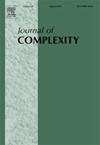A sixth-order bi-parametric iterative method for nonlinear systems: Theory, stability and computational complexity
IF 1.8
2区 数学
Q1 MATHEMATICS
引用次数: 0
Abstract
In this paper, we propose a new bi-parametric three-step iterative method with sixth-order convergence for solving systems of nonlinear equations. The method is formulated using the composition technique, which we uniquely apply twice within a single method - an approach that, to our knowledge, is the first of its kind in the literature. This allows us to incorporate two free disposable parameters, offering flexibility with enhanced performance, stability and adaptability. The local convergence behaviour is rigorously analysed within the framework of Banach spaces, where we establish theoretical bounds for the convergence radius and demonstrate uniqueness conditions under Lipschitz-continuous Fréchet derivative assumptions. The theoretical outcomes are supported by numerical experiments. Lastly, we evaluate the method's efficiency by exploring its basins of attraction and applying it to systems of nonlinear equations and boundary value problems.
非线性系统的六阶双参数迭代法:理论、稳定性和计算复杂度
本文提出了求解非线性方程组的一种新的双参数六阶收敛三步迭代法。该方法是使用合成技术制定的,我们在一种方法中独特地应用了两次——据我们所知,这种方法在文献中是第一次。这允许我们合并两个自由的一次性参数,提供增强性能,稳定性和适应性的灵活性。在Banach空间框架内严格分析了其局部收敛性,建立了收敛半径的理论边界,并证明了在Lipschitz-continuous fr chet导数假设下的唯一性条件。理论结果得到数值实验的支持。最后,我们通过探索其吸引力盆地并将其应用于非线性方程组和边值问题来评估该方法的有效性。
本文章由计算机程序翻译,如有差异,请以英文原文为准。
求助全文
约1分钟内获得全文
求助全文
来源期刊

Journal of Complexity
工程技术-计算机:理论方法
CiteScore
3.10
自引率
17.60%
发文量
57
审稿时长
>12 weeks
期刊介绍:
The multidisciplinary Journal of Complexity publishes original research papers that contain substantial mathematical results on complexity as broadly conceived. Outstanding review papers will also be published. In the area of computational complexity, the focus is on complexity over the reals, with the emphasis on lower bounds and optimal algorithms. The Journal of Complexity also publishes articles that provide major new algorithms or make important progress on upper bounds. Other models of computation, such as the Turing machine model, are also of interest. Computational complexity results in a wide variety of areas are solicited.
Areas Include:
• Approximation theory
• Biomedical computing
• Compressed computing and sensing
• Computational finance
• Computational number theory
• Computational stochastics
• Control theory
• Cryptography
• Design of experiments
• Differential equations
• Discrete problems
• Distributed and parallel computation
• High and infinite-dimensional problems
• Information-based complexity
• Inverse and ill-posed problems
• Machine learning
• Markov chain Monte Carlo
• Monte Carlo and quasi-Monte Carlo
• Multivariate integration and approximation
• Noisy data
• Nonlinear and algebraic equations
• Numerical analysis
• Operator equations
• Optimization
• Quantum computing
• Scientific computation
• Tractability of multivariate problems
• Vision and image understanding.
 求助内容:
求助内容: 应助结果提醒方式:
应助结果提醒方式:


